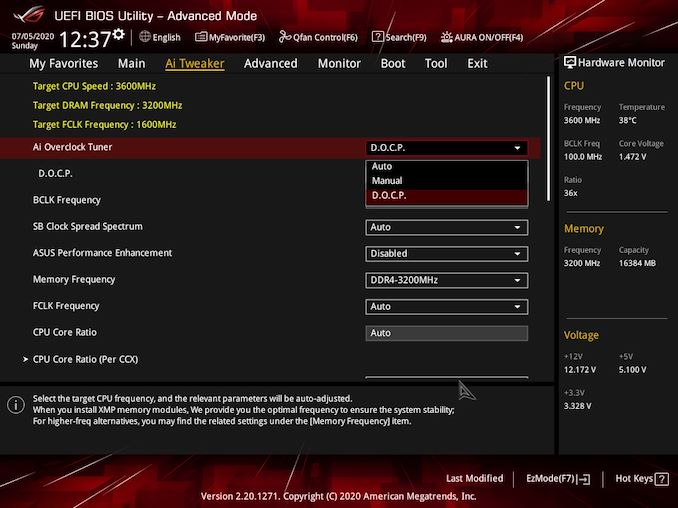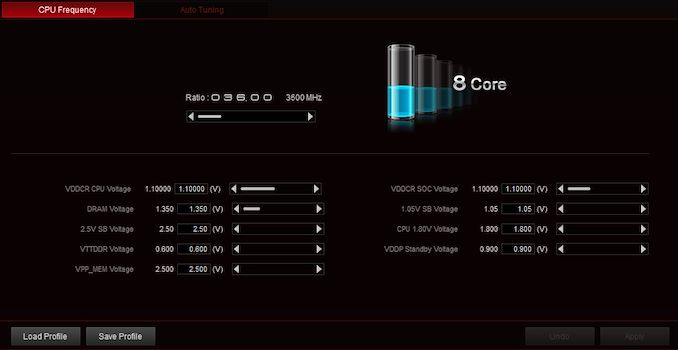The ASUS ROG Strix B550-F Gaming Wi-Fi Motherboard Review: Premium Value
by Gavin Bonshor on July 22, 2020 9:00 AM EST- Posted in
- Motherboards
- AMD
- Asus
- ROG
- AM4
- Strix
- Ryzen 3000
- Ryzen 3700X
- B550
- B550-F
BIOS
The ASUS Republic of Gamers firmware has two different modes for users to select between in the BIOS: EZ and Advanced. The basic 'EZ' mode is for novice users looking to make basic alterations. This includes basic XMP support (which ASUS calls DOCP on its AMD based models). On the basic screen is a list of core information including fan profile speeds, DRAM status, model and firmware version, current CPU Core voltage and motherboard temperature. The design of the firmware includes a dark grey background with white text and red highlights across the top and bottom of the GUI.
Pressing the F7 key allows users to switch between the EZ and the advanced mode, with the advanced more opening up the more familiar features and functions of its ROG based models. There's plenty of overclocking customizations on offer which is typical of an ASUS ROG board, with all of the available overclocking options within the Ai Tweaker section. Here users can customize the CPU settings including CPU frequency in 100 MHz increments, CPU VCore voltages, as well as a host of memory settings including memory voltage, and a section dedicated to memory latencies. One of the main features of AMD's Ryzen 3000 series is Precision Boost Overdrive, and ASUS has included it sown section within the AI Tweaker for users to customize, which allows users to create more aggressive boost profiles.
ASUS has one of the most consistent firmware within the industry, and the Republic of Gamers BIOS on the Strix B550-F Gaming Wi-Fi is a good example of this. The firmware itself is solid and reliable, is responsive to USB keyboard and mice, and is very well laid out and easy to navigate.
Software
One of the unique ASUS implementations to its Republic of Gamers branded motherboards is the Armory Crate, which is pooled into memory on the motherboard and contains basic networking drivers and all the software and utilities. Armory Crate pops up when Windows is first installed, so it looks like somehow ASUS has got into your install image! Thankfully this is just some extra software that helps most users get hold of chipset and controller drivrs as need. If can be disabled in the BIOS if needed. Note this means that the Driver CD traditionally bundled with a motherboard isn't really needed, as long as you have an internet connection.
Some of the most notable utilities in the ASUS package include the ASUS AI Suite 3 software, the ROG Gamefirst VI software, a custom skinned version of the CPU-Z monitoring utility, and its RAMCache III software.
The ASUS AI Suite 3 utility is an amalgamation of various version of its software with functions for overclocking the processor, creating custom fan curve profiles, and changing power delivery power settings. Users can overclock the processor including core voltages including SoC voltage and memory voltages, but users cannot adjust the memory frequency outside of the BIOS. The ASUS AI Suite 3 also allows users to change the fan curve profiles, or even create new ones with more aggressive settings for cooler temperatures, or more subtle settings for less noise.
Also included in the software bundle is a custom ROG skinned version of the CPU-Z monitoring application. There is also ROG GameFirst VI which offers network traffic shaping options, while the Ramcache III software gives users the ability to create pools of high-speed storage using unused DRAM. There's more than enough for users to get to grips within the firmware and software bundle, and as usual, the ASUS package is highly competitive.
























40 Comments
View All Comments
Death666Angel - Wednesday, July 22, 2020 - link
So, single players games aren't a thing anymore? I game, but I don't play multiplayer modes or games.ZipSpeed - Wednesday, July 22, 2020 - link
I dunno, I'm not a competitive gamer by any means and I've been playing online via Wi-Fi for years with no issue. Maybe I'm just less sensitive to the variation because I honestly can't tell the difference wired and wireless.PeachNCream - Wednesday, July 22, 2020 - link
I haven't noticed a substantial difference, but there is a lot of hair splitting going on out there and it is well supported by marketing departments at hardware companies that want to land sales from people. Higher refresh rates, faster mouse polling, overclocking to gain like 2% more performance, Killer NICs that claim to give your game's data packets priority over other packets and so forth all appeal to people that feel like buying all of those things will make them more competitive so they get to teabag someone's corpse more often and feel proud of themselves when their only accomplishment in life is being at or around the top of a leader board. It's sad, but male competitiveness easy to exploit because the individual experiencing it is typically blind to it and will not think rationally about it. Why else to obese men purchase large pickup trucks or glitter bomb glowing computers except to feel empowered in some small way? The WiFi versus wired ethernet thing is just one more way to proclaim you feel superior to someone that doesn't care enough to throw a twisted pair cable across a room or two.CardiWAP - Tuesday, August 11, 2020 - link
Absolute rubbish.Play any fighting game and you can tell right away when somebody is on Wi-Fi. Same thing in shooters.
Wi-Fi really is awful for anything requiring quick action.
Fighting games are based on frames and you have to be aware at every single moment of the frame data of moves.
Any added latency, jitter or any hiccup and the things you thought should have worked (and would have worked in a low latency wired connection) doesn't anymore. You drop a combo, you fail to punish a move, you fail to party and you die.
This particular example that is familiar to me can be extended to any online game requiring quick action, reflexes and constant known data and behavior.
Not using WiFi in these online games is not about anything you've described. It's just about having the best online experience - meaning one closest to offline. And you obviously wreak havoc playing on WiFi it might also be a question of respect for people playing with/against you.
The part about high refresh rate monitor is as misinformed and far-fetched as the Wi-Fi one.
You simply need to drag a simple window in your favourite OS and switch between 60Hz and 144Hz to understand the wonders of the smoothness in high framerate gaming.
Moreover, the switch to flat screen panels really was in some instances a regression that is somewhat mitigated with high refresh rate panels (in the blur department).
Overclocking has been a core part of PC gaming for decades so I won't even bother going further than this.
You might have a leg to stand on regarding Killer NICs and their drivers but they don't jack up the price of the motherboards they are in so it doesn't matter anyway.
MrVibrato - Wednesday, July 22, 2020 - link
I didn't know that you spell ISP like "WiFI" in your corner of the world. ;-PGastec - Sunday, January 3, 2021 - link
WiFi "kills" more than just gaming performances, it's slower than Ethernet cable connection for everything. A WiFi connection between the computer and the router is useful in certain situations but we can't deny that there is a consistent propaganda campaign to convince the consumers to switch from Ethernet to wireless connections, for a good price of course. The more you buy, the more we profit, after all! :)DanNeely - Wednesday, July 22, 2020 - link
"USB 3.0 (5 Gbps) 2 x Type-A Header (2 x ports)"Type A headers are 2 ports, each so this should either be 1x header, or 4x ports.
Ryan Smith - Wednesday, July 22, 2020 - link
Thanks Dan. That's indeed 1 header.mooninite - Wednesday, July 22, 2020 - link
What about a test network performance? The I225-V has two bad revisions (v1 & v2) and there is no known way to know what version you will buy. A benchmark could confirm it.DanNeely - Wednesday, July 22, 2020 - link
If they're not making it explicit in the specsheet any test Gavin did would be of limited value since there would be nothing stopping Asus from having a silicon lottery where not all production runs use the same version of the controller.